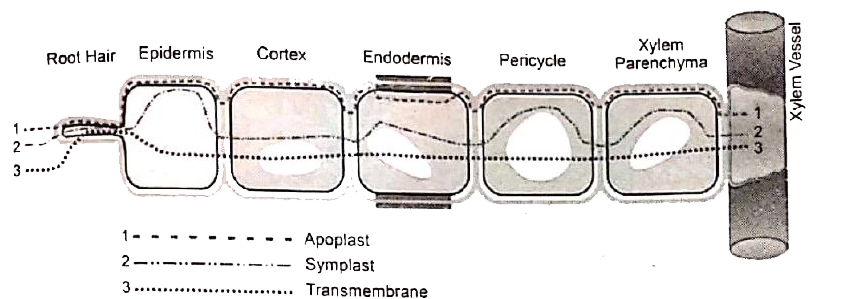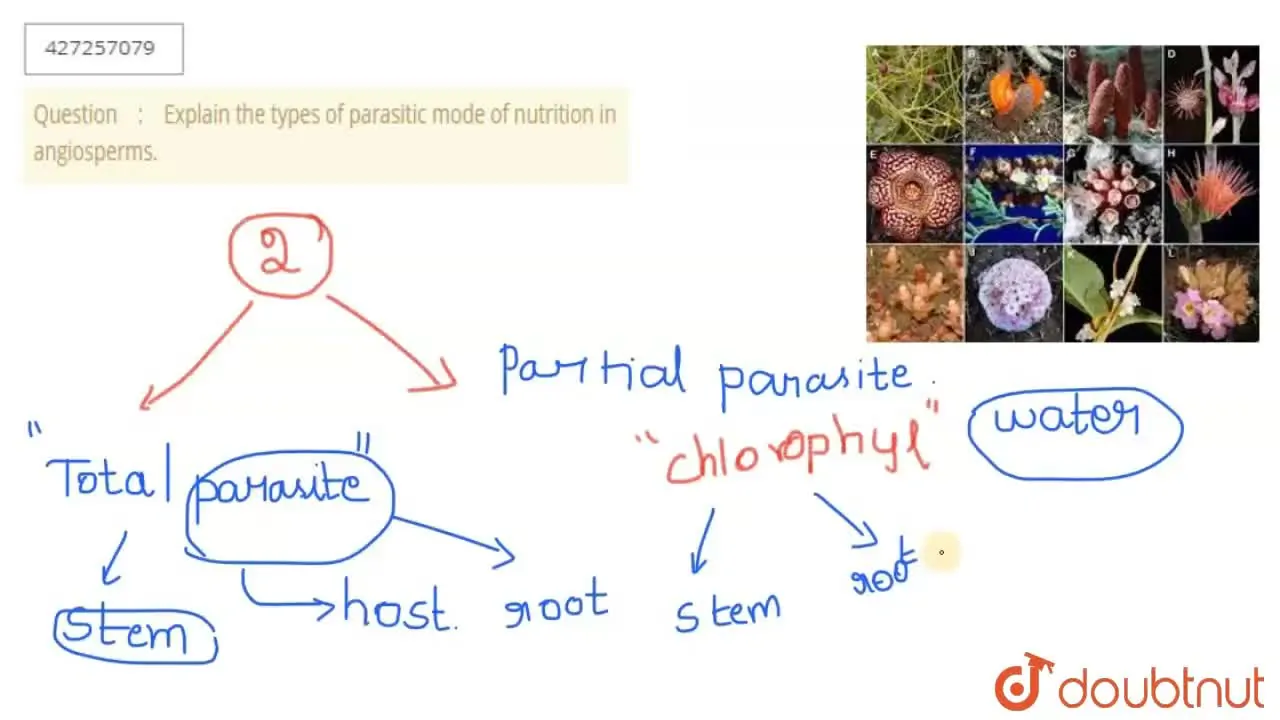Explain the types of parasitic mode of nutrition in angiosperms. Solution in Tamil
There are three possible routes of water.
They are 1. Apoplast, 2. Symplast and 3. Transmembrane route.
1. Apoplast: The apoplast (Greek : apo = away, plast = cell) consists of everything external to the plasma membrane of the living cell. The apoplast cell walls, extra cellular spaces and the interior of dead cells such as vessel elements and tracheids. In the apoplast pathway, water moves exclusively through the cell wall or the non-living part of the plant without crossing any membrane. The apoplast is a continuous system.

2. Symplast : The symplast (Greek : sym = within, plast = cell) consists of the entire mass of cytosol of all the living cell in a plant, as well as the plasmodesmata, the cytoplasmic channel that interconnects them. In the symplastic route, water has to cross plasma membrane to enter the cytoplasm of outer rootcell, then it will move within adjoining cytoplasm through plasmodesmata around the vacuoles without the necessity to cross more membrane,till it reaches xylem.
3. Transmembrane route: In transmembrane pathway water sequentially enters a cell on one side and exits from the cell on the other side. In this pathway, water crosses at least two memebranes for each cell.Transport across the tonoplast is also involved.
Mechanism of water Absorption Kramer (1949) recognized two distinct mechanisms which independently operate in the absorption of water in plants.They are,(i) active absorption (ii) passive absorption. [OR] Parasitic mode of nutirtion in angiosperms:
Organisms deriving their nutrient from another organism (host) and causing disease to the host are called parasites.
(a)Obligate or Total parasite - Completely depends on host for their survival and produces haustoria.
(i) Total stem parasite : The leafless stem twine around the host and produce haustoria. Example : Cuscuta (Dodder), a rootless plant growing on Zizphus, Citrus and so on.
(ii) Total root parasite- They do not have stem axis and grow in the roots of host plants produce haustoria. Example: Rafflesia, Orobanche and Balanophora.
(b). Partial parasite - Plants of this group contain chlorophyll and synthesis carbohydates. Water and mineral requirements are dependent on host plant.
(i) Partial Stem Parasite : Example : Loranthus and Viscum (Mistletoe) Loranthus grows on fig and amngo trees and absorb water and minerals from xylem.
(ii) Partial root parasite : Exampe : Santalum album (Sandal wood tree) in its juvenile stage produces haustoria which grows on roost of many plants.
Related Playlists
- BOOK - FULL MARKSCHAPTER - SAMPLE PAPER -7 (SOLVED)EXERCISE - Bio - Zoology (Part - I)8videos
SAMPLE PAPER -7 (SOLVED)
- BOOK - FULL MARKSCHAPTER - SAMPLE PAPER -7 (SOLVED)EXERCISE - Bio - Zoology (Part - II)7videos
SAMPLE PAPER -7 (SOLVED)
- BOOK - FULL MARKSCHAPTER - SAMPLE PAPER -7 (SOLVED)EXERCISE - Bio - Botany (Part - III)5videos
SAMPLE PAPER -7 (SOLVED)
- BOOK - FULL MARKSCHAPTER - SAMPLE PAPER -3 (SOLVED)EXERCISE - Bio -Zoology Part - IV4videos
SAMPLE PAPER -3 (SOLVED)
- BOOK - FULL MARKSCHAPTER - SAMPLE PAPER-09(UNSOLVED) EXERCISE - BIO ZOOLOGY (PART-IV)4videos
SAMPLE PAPER-09(UNSOLVED)
Similar Questions
Which is not a unit of taxonomic category?
02:08View SolutionWhy are spongin and spicules important to a sponge?
03:00View SolutionDo you think shape of chloroplast is unique for algae. Justify your answer.
02:33View SolutionWrite the general characters of the phylum echinodermata.
04:14View SolutionWrite bried notes on Dipoloblastic can Triploblastic with example.
10:38View SolutionSaprophytic and parasitic modes of nutrition are found in
03:42View SolutionParasitic mode of nutrition is
View SolutionThe organism having parasitic mode of nutrition is:
03:18View SolutionThe mode of nutrition in parasitic organisms is
01:59View SolutionExplain the insectivorous mode of nutrition in angiosperms ?
03:14View SolutionWrite a note on parasitic mode of nutrition ?
10:38View SolutionExplain the types of bacteria based on their mode of Nutrition.
03:32View SolutionParasitic mode of nutrition is
03:08View SolutionOne of the following does not have parasitic mode of nutrition
02:10View SolutionExplain the insectivorous mode of nutrition in angiosperms?
03:14View Solution


